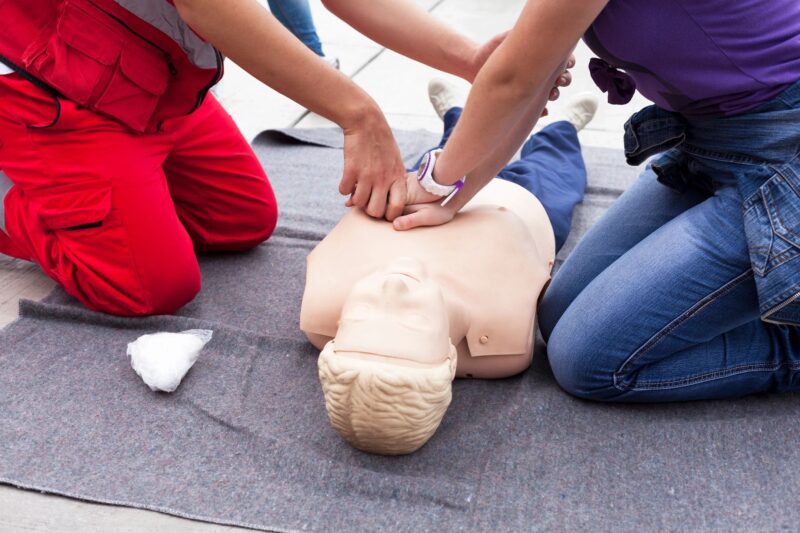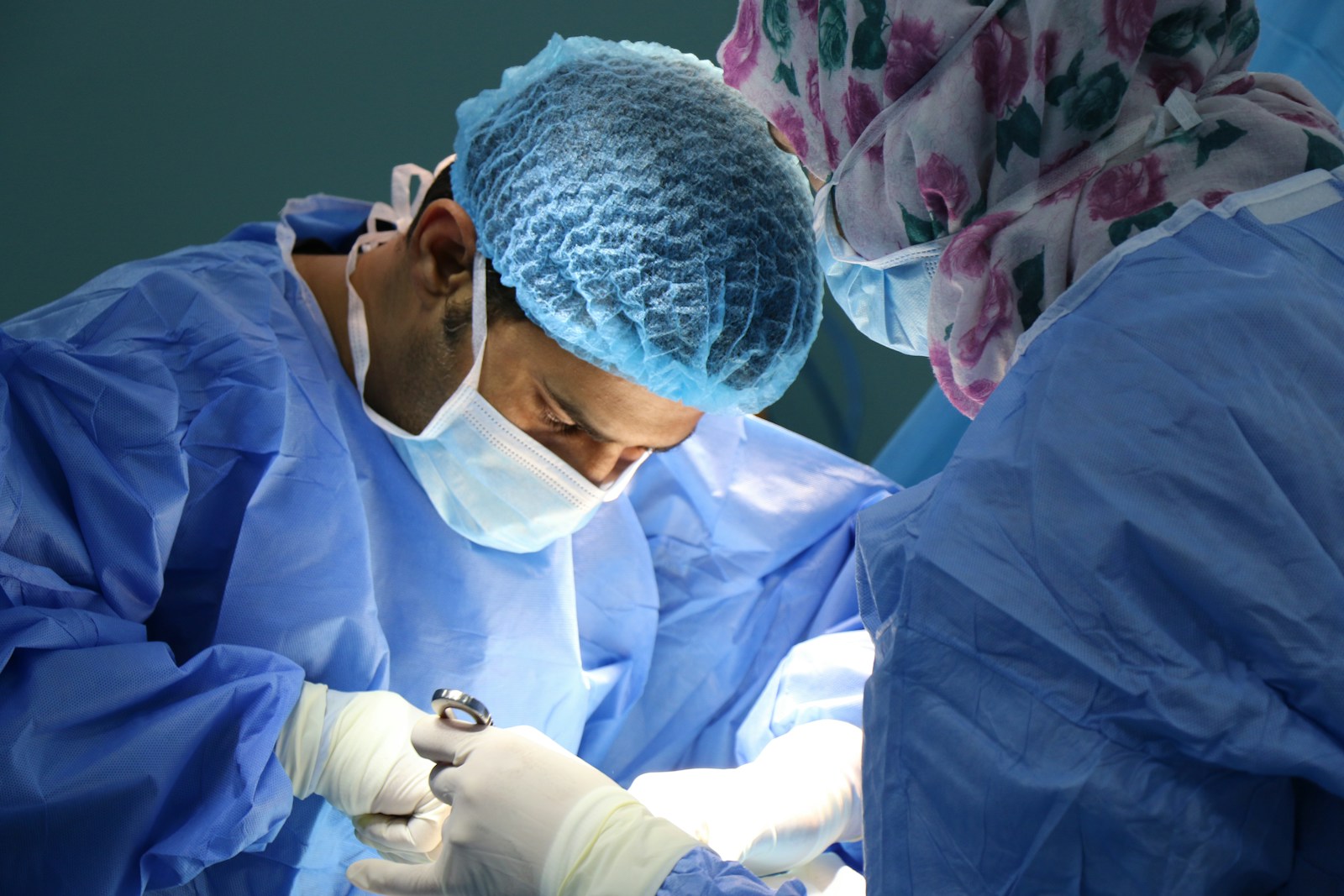Many jobs require knowledge of CPR— childcare workers, flight attendants, and coaches, for example— but there are more techniques and first aid procedures than just doing chest compressions to the beat of “Stayin’ Alive.”

Basic Life Support training goes beyond CPR, adding training involving defibrillators, choking situations, and the links in the Chain of Survival that a lay rescuer can perform for an emergency victim.
Learning these elements, in addition to CPR, comprises the bulk of Basic Life Support (BLS) Certification. Individuals holding that certification stand ready and adequately equipped to assist in emergencies such as cardiac arrests. But what does BLS entail?
Elements of Training
While CPR training can be its own course, BLS goes beyond that, including training in:
- Assessment
- The BLS elements of the Chain of Survival
- CPR
- Ventilations using barrier devices
- Defibrillator operaion
- Dealing with an obstructed airway
- Overdose situations
Courses offered by different organizations may provide other instruction, but these are the basics. Class participants have the opportunity to become versed in and certified to perform these life-saving tasks in the event of an emergency.
Assessment
When an emergency arises, perhaps the most critical thing bystanders can do is assess the situation. BLS training will teach how to determine the best course of action. For instance, emergency care would not include the Heimlich maneuver (for choking) if someone is having a cardiac event.
Assessment involves doing your best to determine what’s wrong with the person in question. After all, it’s hard to follow a map to a location if you don’t know the location.
Learning to assess a medical emergency situation is critical to ensuring that the person in distress gets the care he needs to survive.
Along with assessment skills, BLS courses stress critical thinking and problem-solving. Having some ability to do these things is invaluable in an emergency since rarely is anything happening as orderly as it did in the classroom.
The BLS Elements of the Chain of Survival
The Chain of Survival refers to a sequence of actions that, when taken, significantly increase the chances that someone suffering a cardiac arrest will survive it. BLS training covers the chain and the links that a lay rescuer should perform while emergency service personnel such as paramedics are on their way.
The chain aims to do four things:
- Prevent cardiac arrest
- Gain time
- Restart the person’s heart
- Getting the person into recovery
The average lay rescuer will not have much to do with the last objective, as it usually occurs in a hospital setting. However, knowing the goals of the Chain of Survival helps us know, understand, and remember the links of the chain, which are:
- Recognize early signs: Recognizing the early signs of an impending cardiac event and knowing what an active cardiac arrest looks like.
- Call 911: Calling 911 gets paramedics en route to you but will also put you on the phone with a dispatcher who can help guide your actions as you administer Basic Life Support.
- Start CPR: Starting CPR can triple the chances that someone having a cardiac arrest will survive it.
- Use an available AED: According to the National Institutes of Health, an available AED makes a victim 67% more likely to survive a cardiac arrest.
- Medical personnel takes over: Turning the situation over to emergency medical personnel means the lay rescuer’s part in the cardiac arrest is over.
- Hospitalization: Getting the victim to a hospital for care and recovery is the last link in the chain.
BLS certification can teach you the first four links of the chain, making lay rescuers much more effective in the fight to save a life.
CPR
Cardiopulmonary Resuscitation (CPR) is one of the most important tools in a life support provider’s arsenal. Used when a person has stopped breathing or whose heart has stopped, CPR performs two functions:
- It attempts to get the heart beating again and restart breathing.
- It helps keep blood flowing to major organs, despite the absence of a heartbeat.
Most of us know what CPR is and have a basic idea of how to do it, as just about everyone has seen it performed on TV. However, there’s more to it than what medical drama actors do, and any medical professional will tell you that they don’t do it right on television.
CPR also involves the CAB model:
- Compressions: Pressing on the chest in rhythm.
- Airway clearance: Ensuring that the person can get air to their lungs once they start breathing again.
- Breathing: Breathing for the person using mouth-to-mouth or a manual resuscitator bag to help restart breathing.
Knowing CPR is important, and there are different techniques governing its use on adults and children, but it’s not the only too you’ll learn in Basic Life Support training.
Ventilations With Barrier Devices
A generation ago, CPR involved mouth-to-mouth resuscitation as an automatic procedure element.
But as infectious diseases have come more and more to the forefront of the public consciousness (especially in the wake of a global pandemic), the medical establishment has recognized the possible dangers to a rescuer.
In light of that, barrier devices have become common.
As one element of personal protective equipment (PPE), barrier devices allow for applying mouth-to-mouth, or some approximation, without coming into contact with another person’s mucous membranes or bodily fluids.
While putting your mouth on someone else’s and blowing into their lungs is a relatively straightforward endeavor, using a barrier device can complicate things.
Barrier devices can be a mask with a one-way valve so you can place it over the victim’s mouth and blow into it, a face shield, or even a bag mask, where the airflow comes from squeezing the bag. You don’t put your mouth near the victim’s mouth with one of those.
Training in how to use barrier devices is essential. The chances that you’ll effectively use one in an emergency if you’ve never even seen one before will be low. BLS training will at least expose you to them and how to employ them.
Defibrillator Operation
Automated External Defibrillators (AEDs) have become commonplace in many public spaces. If you know what you’re looking for, you’ll notice them in churches, sports arenas, schools, and even restaurants.
You may be more familiar with the defibrillators from hospital settings in movies or on TV, where the doctor takes two paddles, rubs them together, shouts, “Clear!” and then shocks the patient, hoping to restart a cardiac rhythm.
AEDs work on the same principle, but the A in “Automated” means that the unit does most of the work, determining how powerful a shock it should deliver and when.
But you have to know how to operate one, so BLS involves AED instruction so that if you face a situation where one is required, you’ll have the necessary knowledge and instruction to use it.
Dealing With Obstructed Airways
Choking can be a terrifying experience for the victim, but it can also scare the people around them, as it’s traumatic to watch. Since about 5,000 Americans die from choking yearly, knowing how to deal with the situation is important.
Basic Life Support training teaches the procedures for clearing obstructed airways in various situations, whether the person across the table from you starts choking or you encounter someone who has lost consciousness.
Training includes the Heimlich maneuver and visual inspection of the airway and when (and when not) to smack them on the back.
Overdose Situations
While naloxone, also known as Narcan, has emerged as a wonder drug regarding opioid overdoses, it’s not as readily available in public as AEDs are these days.
BLS training will go over naloxone administration, but other actions must be taken, especially if Narcan isn’t on hand.
Class instruction covers the sternum rub, getting the person to wake up, and, if necessary, applying rescue breathing.
Knowing what to do in an overdose emergency has become more important as opioid use continues across the country. Almost 100,000 people died as a result in 2020 alone.
Getting Certified
Basic Life Support training can save lives, so it’s good to have. But you may work a job for which the certification is required. You’ll need to find an accredited course, register, and participate in the class to get your certification.
Since techniques can change over time, it’s important to remember that certification must be renewed every two years. Most institutions that teach certification courses also teach recertification classes. You’ll probably be able to get recertified at the same place you got your initial training.
Conclusion
Basic Life Support training provides for the competent administration of CPS and other life-saving techniques. Holding a BLS certification may make you more employable, or your line of work may require it.
Either way, it will provide you with the tools needed in various emergency situations, irrespective of whether they involve your job or just being in the right place at the right time for an individual needing emergency medical attention.
The care you provide before paramedics arrive can save someone’s life.
Author Bio for Kate Macmorn
Kate Macmorn
Communications Director
AMRI
Kate is the communications director for the American Medical Resource Institute, where they’ve trained over a million healthcare professionals to study for, earn and maintain life support certifications that allow them to better respond to cardiac emergencies. When not in the office, you can find Kate practicing her tennis skills. She also frequents live music venues and is always looking for her next creative hobby.


